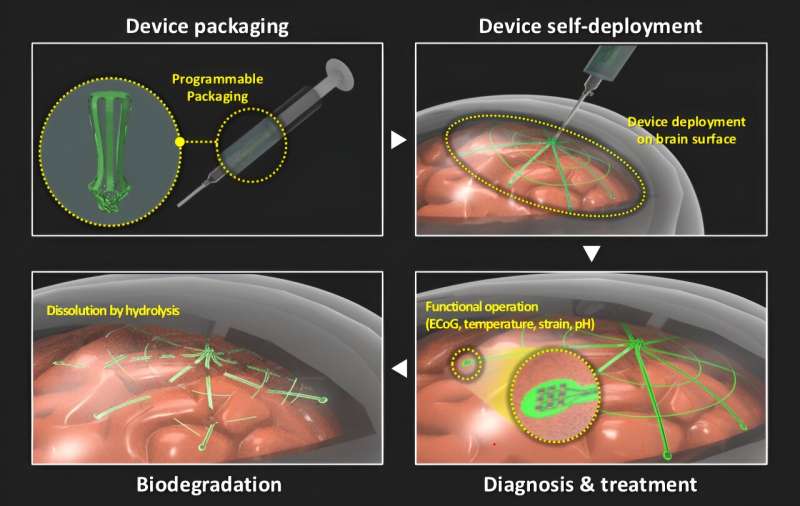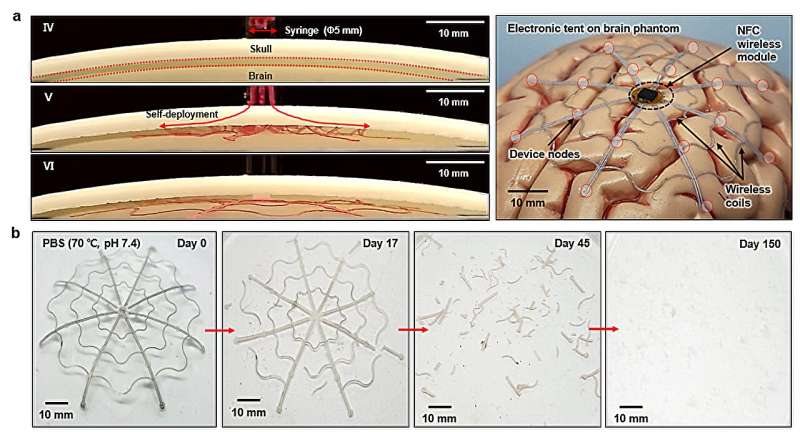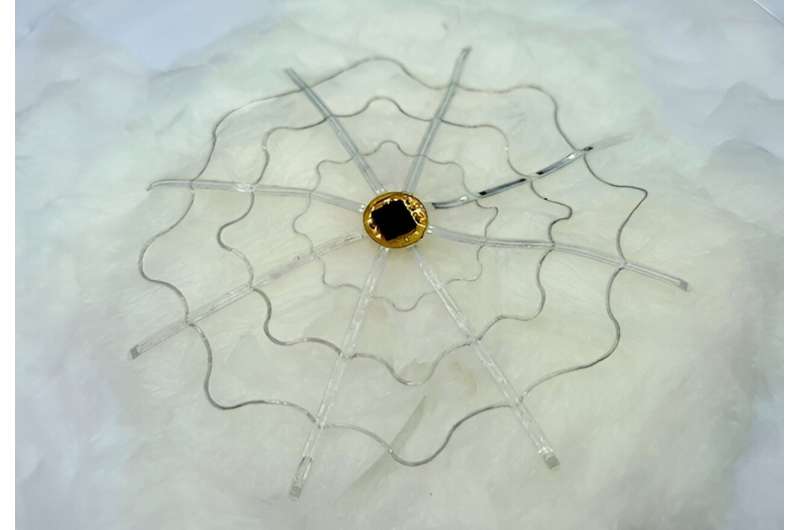August 25, 2024 feature
This article has been reviewed according to Science X's editorial process and policies. Editors have highlighted the following attributes while ensuring the content's credibility:
fact-checked
peer-reviewed publication
trusted source
proofread
Self-deployable, biodegradable electrode offers minimally invasive brain signal monitoring

Sensors that can be easily and safely introduced in the brain could have important medical applications and could also contribute to the development of brain-interfacing devices. While significant progress has been made toward the development of these sensors, most existing devices can only be deployed via invasive surgical procedures that can have numerous complications.
Researchers at Seoul National University and other institutes in South Korea recently created a new biodegradable and self-deployable tent electrode that could be far easier to insert onto the surface of the human brain. Their proposed electrode design, outlined in Nature Electronics, could naturally degrade inside the human body without leaving any residues, which means that once it is inserted in the body it does not need to be surgically removed.
"Our recent paper was born out of a growing awareness of the clinical challenges linked to the implantation of electrodes via invasive brain surgery," Seung-Kyun Kang, corresponding author of the paper, told Medical Xpress.
"Conventional large-area electrodes require extensive skull removal surgery to implant on the brain, which might pose significant risks of complications such as bleeding, swelling, cerebrospinal fluid leakage, or infection. After use, leftover electrodes on the brain may trigger unwanted immune reactions or infections due to biofilm formation, requiring a secondary surgery for removal."
The tent electrode created by the team is a sensing device with a pyramidal shape, which is typically used to collect electroencephalography (EEG) recordings and other neurophysiological data.
"The electronic tent electrode we developed can be deployed using a syringe in a minimally invasive manner to measure brain signals, and then can be prompted to dissolve and disappear within the body after use," said Kang. "Our technology is particularly promising for precise diagnostics, such as the diagnosis of epilepsy, as well as neural prosthetics and brain-computer interfaces (BCI) that require interfacing with various brain regions."
The team's electrode has a tent-like structure that can be easily packaged and unfolded. The device is partly made of shape memory polymers; flexible materials that can recover their original shape after they are pulled or squeezed into a narrow enclosing. Leveraging the properties of these materials, the electrodes can thus easily be introduced into confined spaces within the brain surface through a small hole.

"We also integrated biodegradable inorganic electronic sensors with nanometer thickness on an electronic tent to provide flexibility," Kang explained. "Due to the sensors' mechanical flexibility, we were able to deliver various electronic devices without damage to the sensors during injection to measure various neurophysiological signals from the brain."
Initial tests assessing the performance of the team's tent electrodes showed that they can retain their electrical performance throughout their lifespan and fully decompose after use without leaving any residues. While they are operating, the sensors can record electrical activity around them and transmit the data they collect to other devices.
As they are biodegradable and non-toxic, the new sensors developed by Kang and his colleagues would not need to be removed after they are introduced inside the human body. This feature is highly appealing for a wide range of real-world applications, ranging from precision medicine to the development of safe brain–computer interfaces (BCIs).
"The electronic tent can be used for diagnosing epilepsy, which can require large-area mapping for localizing affected areas," said Jae-Young Bae, lead author of the paper. "Generally, epileptic seizures engage intricate networks of brain regions, often located deep within the brain. Inserting electrodes into these deep and multiple regions to pinpoint seizure origins can lead to considerable damage. Furthermore, since seizures are not constant, extended monitoring is often required."
Existing methods to diagnose epilepsy entail the mapping of brain activity over set periods of time, typically around two weeks. This is often done using electrodes that can capture what is happening across the brain, allowing doctors to locate the origin of the seizures experienced by patients.
Once doctors have been able to diagnose epilepsy or identified other sources of a patient's seizures, they can start devising suitable therapeutic interventions. Before that, however, they need to surgically remove the implanted electrodes from the patient's brain.

"Our biodegradable electronic tent could reduce the surgical burden associated with the implantation of large-area mapping electrodes and eliminate the need for secondary removal surgery," Bae explained. "The tent electrode may thus offer a minimally invasive diagnostic solution compared to traditional methods that required large-area skull removal for electrode insertion."
In addition to potentially facilitating the diagnosis of epilepsy and other brain-related conditions, the new tent electrodes could be used to develop BCIs. These are emerging interfaces that could enhance human–machine interactions and aid the medical rehabilitation of patients.
"For instance, BCI can aid in motor recovery for stroke patients and control neuroprosthetics or external robotic systems," Bae said. "Large-area BCI are more sensitive and can enable the comprehensive mapping of brain regions, enabling a more accurate localization of neural activity, aiding the study of complex brain functions and improving targeting for therapeutic interventions. However, BCI technology faces challenges in risks associated with invasive procedures. We expect that the tent electrode can minimize the risk of use in BCI technology."
This recent work by Kang and his colleagues could soon contribute to the development of safer BCIs and implantable devices for diagnosing various medical conditions. As part of their next studies, the researchers also plan to explore the possibility of using various bio-degradable materials to deliver targeted therapeutic interventions, such as chemo- and phototherapy.
"In the future, we also intend to collaborate with clinical partners to test our biodegradable electronic tent technology in clinical applications," added Kang. "This will allow us to run field trials in medical settings to assess the performance and degradation behavior of our technology outside of laboratory settings. Ultimately, our goal is to incorporate these biodegradable electronics into medical devices, providing minimally invasive diagnostic or therapeutic solutions."
More information: Jae-Young Bae et al, A biodegradable and self-deployable electronic tent electrode for brain cortex interfacing, Nature Electronics (2024). DOI: 10.1038/s41928-024-01216-x
© 2024 Science X Network




















